Assessing Tropical Cyclone Risk in Australia Using Community Exposure–Vulnerability Indices
Abstract
:1. Introduction
2. Materials and Methods
2.1. Study Area
2.2. Selecting Tropical Cyclone Indicators
2.3. Exposure
2.3.1. Population Density
2.3.2. Hospitals
2.3.3. Residential Housing
2.3.4. Land Use Land Cover (LULC)
2.4. Vulnerability
2.4.1. Index of Relative Socio-economic Disadvantage (IRSD)
2.4.2. Vulnerable Age Groups
2.4.3. Core Assistance
2.4.4. Travel to Hospital Difficulty
2.4.5. Residential Housing Building Codes
2.4.6. Topographic Position Index—Critical Infrastructure
2.4.7. Soil Moisture
2.4.8. Topographic Position Index—Nature Conservation and Forestry
2.4.9. Topographic Position Index—Animal Agriculture and Cropping
2.5. Social, Environment, Infrastructure Indices’ Calculation and Mapping
2.6. Exposure–Vulnerability Index
2.7. Normalisation Technique
2.8. Indicator Weighting
3. Results
4. Discussion
4.1. Social Exposure–Vulnerability
4.2. Infrastructure Exposure–Vulnerability
4.3. Environment Exposure–Vulnerability
4.4. Overall Exposure–Vulnerability Index
5. Conclusions
Author Contributions
Funding
Data Availability Statement
Acknowledgments
Conflicts of Interest
Appendix A. List of All 16 Variables That Are Used to Create the IRSD Index. All Variables Are Indicators of Disadvantage
- INC_LOW: % of people with stated household equivalised income between AUD 1 and AUD 25,999 per year
- CHILDJOBLESS: % of families with children under 15 years of age who live with jobless parents
- NONET: % of occupied private dwellings with no internet connection
- NOYEAR12ORHIGHER: % of people aged 15 years and over whose highest level of education is Year 11 or lower
- UNEMPLOYED: % of people (in the labour force) who are unemployed
- OCC_LABOUR: % of employed people classified as Labourers
- LOWRENT: % of occupied private dwellings paying rent less than AUD 215 per week (excluding AUD 0 per week)
- ONEPARENT: % of one-parent families with dependent offspring only
- DISABILITYU70: % of people under the age of 70 who have a long-term health condition or disability and need assistance with core activities
- SEPDIVORCED: % of people aged 15 years and over who are separated or divorced
- OCC_DRIVERS: % of employed people classified as Machinery Operators and Drivers
- OCC_SERVICE_L: % of employed people classified as low-skill Community and Personal Service workers
- NOCAR: % of occupied private dwellings with no cars
- OVERCROWD: % of occupied private dwellings requiring one or more extra bedrooms
- NOEDU: % of people aged 15 years and over who have no educational attainment
- ENGLISHPOOR: % of people who do not speak English well
Appendix B. Map of Tropical Cyclone Social Exposure in the Six LGAs Surrounding TC Debbie Landfall, with Values after Logarithmic Min–Max Normalisation (QGIS 3.30 Software)
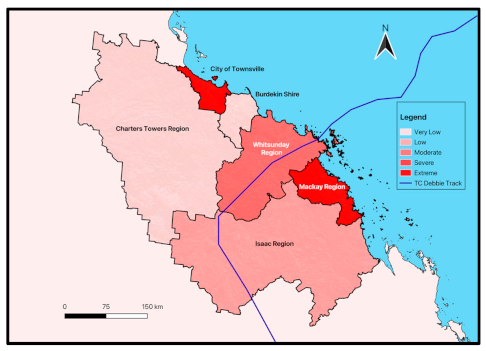
Appendix C. Map of Tropical Cyclone Social Vulnerability in the Six LGAs Surrounding TC Debbie Landfall, with Values after Logarithmic Min–Max Normalisation (QGIS 3.30 Software)

Appendix D. Map of Land Use Classifications of Animal Agriculture and Cropping in the Six LGAs Surrounding TC Debbie Landfall (QGIS 3.30 Software)

Appendix E. Map of All Eight Land Use Classifications in the Six LGAs Surrounding TC Debbie Landfall (QGIS 3.30 Software)

References
- UNDRR. Hazard Definition and Classification Review. I. S. Council. 2020. Available online: https://council.science/wp-content/uploads/2020/06/UNDRR_Hazard-Report_DIGITAL.pdf (accessed on 14 September 2023).
- Turton, S.M. Securing Landscape Resilience to Tropical Cyclones in Australia’s Wet Tropics under a Changing Climate: Lessons from Cyclones Larry (and Yasi). Geogr. Res. 2012, 50, 15–30. [Google Scholar] [CrossRef]
- Do, C.; Kuleshov, Y. Multi-Hazard Tropical Cyclone Risk Assessment for Australia. Remote Sens. 2023, 15, 795. [Google Scholar] [CrossRef]
- Yeasmin, A.; Chand, S.; Turville, C.; Sultanova, N. Detection and verification of tropical cyclones and depressions over the South Pacific Ocean basin using ERA-5 reanalysis dataset. Int. J. Climatol. 2021, 41, 5318–5330. [Google Scholar] [CrossRef]
- Chand, S.S.; Dowdy, A.J.; Ramsay, H.A.; Walsh, K.J.E.; Tory, K.J.; Power, S.B.; Bell, S.S.; Lavender, S.L.; Ye, H.; Kuleshov, Y. Review of tropical cyclones in the Australian region: Climatology, variability, predictability, and trends. Wiley Interdiscip. Rev. Clim. Change 2021, 12, e686. [Google Scholar] [CrossRef]
- Kim, H.M.; Webster, P.J.; Curry, J.A. Impact of Shifting Patterns of Pacific Ocean Warming on North Atlantic Tropical Cyclones. Science 2009, 325, 77–80. [Google Scholar] [CrossRef]
- Dare, R.A.; Davidson, N.E.; McBride, J.L. Tropical Cyclone Contribution to Rainfall over Australia. Mon. Weather Rev. 2012, 140, 3606–3619. [Google Scholar] [CrossRef]
- Kuleshov, Y. “Climate Change and Southern Hemisphere Tropical Cyclones” International Initiative: Twenty Years of Successful Regional Cooperation. In Climate Change, Hazards and Adaptation Options. Climate Change Management; Filho, W.L., Nagy, G., Borga, M., Muñoz, D.C., Magnuszewski, A., Eds.; Springer: Berlin/Heidelberg, Germany, 2020; pp. 411–439. [Google Scholar] [CrossRef]
- ICA. Climate Change Impact Series: Tropical Cyclones and Future Risks [Impact Series]. Insurance Council of Australia. 2021. Available online: https://insurancecouncil.com.au/wp-content/uploads/2021/12/2021Nov_Tropical-Cyclones-and-Future-Risks_final.pdf (accessed on 14 September 2023).
- Coates, L.; Haynes, K.; Radford, D.; D’Arcy, R.; Smith, C.; van den Honert, R.; Gissing, A. An Analysis of Human Fatalities from Cyclones, Earthquakes and Severe Storms in Australia. Bushfire and Natural Hazards Cooperative Research Centre. 2017. Available online: https://www.bnhcrc.com.au/sites/default/files/managed/downloads/cyclone_earthquake_and_storm_-_fatalities_report_28-12-2016.pdf (accessed on 14 September 2023).
- Birkmann, J.; Buckle, P.; Jaeger, J.; Pelling, M.; Setiadi, N.; Garschagen, M.; Fernando, N.; Kropp, J. Extreme events and disasters: A window of opportunity for change? Analysis of organizational, institutional and political changes, formal and informal responses after mega-disasters. Nat. Hazards 2010, 55, 637–655. [Google Scholar] [CrossRef]
- Henderson-Sellers, A.; Zhang, H.; Berz, G.; Emanuel, K.; Gray, W.; Landsea, C.; Holland, G.; Lighthill, J.; Shieh, S.L.; Webster, P.; et al. Tropical Cyclones and Global Climate Change: A Post-IPCC Assessment. Bull. Am. Meteorol. Soc. 1998, 79, 19–38. [Google Scholar] [CrossRef]
- IPCC. Climate Change 2022: Impacts, Adaptation, and Vulnerability. Contribution of Working Group II to the Sixth Assessment Report of the Intergovernmental Panel on Climate Change (5). 2022. Available online: https://report.ipcc.ch/ar6/wg2/IPCC_AR6_WGII_FullReport.pdf (accessed on 14 September 2023).
- Knutson, T.R.; McBride, J.L.; Chan, J.; Emanuel, K.; Holland, G.; Landsea, C.; Held, I.; Kossin, J.P.; Srivastava, A.K.; Sugi, M. Tropical cyclones and climate change. Nat. Geosci. 2010, 3, 157–163. [Google Scholar] [CrossRef]
- Ishak, E.; Rahman, A. Examination of changes in flood data in Australia. Water 2019, 11, 1734. [Google Scholar] [CrossRef]
- Schwarz, I.; Kuleshov, Y. Flood Vulnerability Assessment and Mapping: A Case Study for Australia’s Hawkesbury-Nepean Catchment. Remote Sens. 2022, 14, 4894. [Google Scholar] [CrossRef]
- Chen, P. On the Diversity-Based Weighting Method for Risk Assessment and Decision-Making about Natural Hazards. Entropy 2019, 21, 269. [Google Scholar] [CrossRef]
- Du, X.; Lin, X. Conceptual Model on Regional Natural Disaster Risk Assessment. Procedia Eng. 2012, 45, 96–100. [Google Scholar] [CrossRef]
- Knutson, T.; Camargo, S.J.; Chan, J.C.L.; Emanuel, K.; Ho, C.-H.; Kossin, J.; Mohapatra, M.; Satoh, M.; Sugi, M.; Walsh, K.; et al. Tropical Cyclones and Climate Change Assessment: Part II: Projected Response to Anthropogenic Warming. Bull. Am. Meteorol. Soc. 2020, 101, E303–E322. [Google Scholar] [CrossRef]
- Ng, B.; Walsh, K.; Lavender, S. The contribution of tropical cyclones to rainfall in northwest Australia: Tropical cyclone rainfall australia. Int. J. Climatol. 2015, 35, 2689–2697. [Google Scholar] [CrossRef]
- Crichton, D. The Risk Triangle Natural Disaster Management, Tudor Rose, London. 1999. Available online: https://www.unisdr.org/files/7956_naturaldisastermanagementtor.pdf (accessed on 14 September 2023).
- Anderson-Berry, L.; King, D. Mitigation of the Impact of Tropical Cyclones in Northern Australia through Community Capacity Enhancement. Mitig. Adapt. Strateg. Glob. Change 2005, 10, 367–392. [Google Scholar] [CrossRef]
- Cutter, S.L.; Emrich, C.T. Moral Hazard, Social Catastrophe: The Changing Face of Vulnerability along the Hurricane Coasts. Ann. Am. Acad. Political Soc. Sci. 2006, 604, 102–112. [Google Scholar] [CrossRef]
- Lindley, S.J.; Handley, J.F.; Theuray, N.; Peet, E.; McEvoy, D. Adaptation Strategies for Climate Change in the Urban Environment: Assessing Climate Change Related Risk in UK Urban Areas. J. Risk Res. 2006, 9, 543–568. [Google Scholar] [CrossRef]
- Tiepolo, M.; Belcore, E.; Braccio, S.; Issa, S.; Massazza, G.; Rosso, M.; Tarchiani, V. Method for fluvial and pluvial flood risk assessment in rural settlements. MethodsX 2021, 8, 101463. [Google Scholar] [CrossRef]
- Do, C.; Saunders, G.; Kuleshov, Y. Assessment of Tropical Cyclone Risk to Coral Reefs: Case Study for Australia. Remote Sens. 2022, 14, 6150. [Google Scholar] [CrossRef]
- Hoque, M.A.-A.; Phinn, S.; Roelfsema, C. A systematic review of tropical cyclone disaster management research using remote sensing and spatial analysis. Ocean. Coast. Manag. 2017, 146, 109–120. [Google Scholar] [CrossRef]
- Do, C.; Kuleshov, Y. Tropical cyclone multi-hazard risk mapping for Queensland, Australia. Nat. Hazards 2023, 116, 3725–3746. [Google Scholar] [CrossRef]
- Duvat, V.K.E.; Magnan, A.K.; Etienne, S.; Salmon, C.; Pignon-Mussaud, C. Assessing the impacts of and resilience to Tropical Cyclone Bejisa, Reunion Island (Indian Ocean). Nat. Hazards 2016, 83, 601–640. [Google Scholar] [CrossRef]
- King, D.; MacGregor, C. Using Social Indicators to Measure Community Vulnerability to Natural Hazards. Aust. J. Emerg. Manag. 2000, 15, 52–57. [Google Scholar]
- Logan, J.R.; Xu, Z. Vulnerability to Hurricane Damage on the U.S. Gulf Coast Since 1950. Geogr. Rev. 2015, 105, 133–155. [Google Scholar] [CrossRef]
- Schmidtlein, M.C.; Deutsch, R.C.; Piegorsch, W.W.; Cutter, S.L. Sensitivity Analysis of the Social Vulnerability Index. Risk Anal. 2008, 28, 1099–1114. [Google Scholar] [CrossRef]
- Yonson, R.; Noy, I.; Gaillard, J.C. The measurement of disaster risk: An example from tropical cyclones in the Philippines. Rev. Dev. Econ. 2018, 22, 736–765. [Google Scholar] [CrossRef]
- Peduzzi, P.; Chatenoux, B.; Dao, H.; De Bono, A.; Herold, C.; Kossin, J.; Mouton, F.; Nordbeck, O. Global trends in tropical cyclone risk. Nat. Clim. Change 2012, 2, 289–294. [Google Scholar] [CrossRef]
- Rank, M.R.; Hirschl, T.A. The Link Between Population Density and Welfare Participation. Demography 1993, 30, 607–622. [Google Scholar] [CrossRef]
- Ghosh, S.; Mistri, B. Assessing coastal vulnerability to environmental hazards of Indian Sundarban delta using multi-criteria decision-making approaches. Ocean. Coast. Manag. 2021, 209, 105641. [Google Scholar] [CrossRef]
- Ghosh, S.; Mistri, B. Analyzing the multi-hazard coastal vulnerability of Matla–Bidya inter-estuarine area of Indian Sundarbans using analytical hierarchy process and geospatial techniques. Estuar. Coast. Shelf Sci. 2022, 279, 108144. [Google Scholar] [CrossRef]
- Mladineo, N.; Mladineo, M.; Benvenuti, E.; Kekez, T.; Nikolić, Ž. Methodology for the Assessment of Multi-Hazard Risk in Urban Homogenous Zones. Appl. Sci. 2022, 12, 12843. [Google Scholar] [CrossRef]
- De Brito, M.M.; Evers, M. Multi-criteria decision-making for flood risk management: A survey of the current state of the art. Nat. Hazards Earth Syst. Sci. 2016, 16, 1019–1033. [Google Scholar] [CrossRef]
- Sahoo, B.; Bhaskaran, P.K. Multi-hazard risk assessment of coastal vulnerability from tropical cyclones–A GIS based approach for the Odisha coast. J. Environ. Manag. 2018, 206, 1166–1178. [Google Scholar] [CrossRef]
- Tropical Cyclone Debbie Technical Report, Bureau of Meteorology, 2018, 191p. Available online: http://www.bom.gov.au/cyclone/history/database/Tropical-Cyclone-Debbie-Technical-Report-Final.pdf (accessed on 14 September 2023).
- Alves, B. Number of deaths reported caused by tropical cyclones worldwide from 1970 to 2019. Statista. 2023. Available online: https://www.statista.com/statistics/1297464/global-reported-deaths-tropical-cyclones/#:~:text=Global%20deaths%20from%20tropical%20cyclones%201970%2D2019&text=Since%201970%2C%20almost%20800%20thousand,been%20registered%20across%20the%20globe (accessed on 14 September 2023).
- Deng, D.; Ritchie, E.A. High-Resolution Simulation of Tropical Cyclone Debbie (2017). Part I: The Inner-Core Structure and Evolution during Offshore Intensification. J. Atmos. Sci. 2023, 80, 441–456. [Google Scholar] [CrossRef]
- Fekete, A. Validation of a social vulnerability index in context to river-floods in Germany. Nat. Hazards Earth Syst. Sci. 2009, 9, 10. [Google Scholar] [CrossRef]
- Noji, E.K. Analysis of medical needs during disasters caused by tropical cyclones: Anticipated injury patterns. J. Trop. Med. Hyg. 1993, 96, 370–376. Available online: https://pubmed.ncbi.nlm.nih.gov/8254716/ (accessed on 14 September 2023).
- Rotheray, K.R.; Aitken, P.; Goggins, W.B.; Rainer, T.H.; Graham, C.A. Epidemiology of injuries due to tropical cyclones in Hong Kong: A retrospective observational study. Injury 2012, 3, 2055–2059. [Google Scholar] [CrossRef]
- Victoria State Government (VSG). VicMap Address. Department of Transport and Planning. 1 May 2023. Available online: https://www.land.vic.gov.au/maps-and-spatial/spatial-data/vicmap-catalogue/vicmap-address (accessed on 14 September 2023).
- Sudha, R.V.; Satyanarayana, A.V.; Bhaskaran, P.K. Coastal vulnerability assessment studies over India: A review. Nat. Hazards 2015, 77, 405–428. [Google Scholar] [CrossRef]
- Ziegelaar, M.; Kuleshov, Y. Flood Exposure Assessment and Mapping: A Case Study for Australia’s Hawkesbury-Nepean Catchment. Hydrology 2022, 9, 193. [Google Scholar] [CrossRef]
- Inspector-General Emergency Management (IGEM). The Cyclone Debbie Review (Report 1). Queensland Government. 2018. Available online: https://www.igem.qld.gov.au/sites/default/files/2019-02/Cyclone%20Debbie%20Review%20Rpt1-17-18_PUBLIC_WEB.pdf (accessed on 14 September 2023).
- Australian Uniform Building Regulations Coordinating Council (AUBRCC). Building Code of Australia, 1988. Building Code of Australia. 1988. Available online: https://ncc.abcb.gov.au/system/files/ncc/BCA%201988_0.pdf (accessed on 14 September 2023).
- Household Resilience Program (HRP). HPR Roof Replacement. Unite & Recover Queensland Government. 2020. Available online: https://www.hpw.qld.gov.au/__data/assets/pdf_file/0014/11804/hrp-roof-replacement-factsheet.pdf (accessed on 14 September 2023).
- Mitchell, P.J.; Benyon, R.G.; Lane, P.J. Responses of evapotranspiration at different topographic positions and catchment water balance following a pronounced drought in a mixed species eucalypt forest, Australia. J. Hydrol. 2012, 440, 62–74. [Google Scholar] [CrossRef]
- Jones, R.A.; Spoor, G.; Thomasson, A.J. Vulnerability of subsoils in Europe to compaction: A preliminary analysis. Soil Tillage Res. 2003, 73, 131–143. [Google Scholar] [CrossRef]
- Cui, Y.; Cheng, D.; Choi, C.E.; Jin, W.; Lei, Y.; Kargel, J.S. The cost of rapid and haphazard urbanization: Lessons learned from the Freetown landslide disaster. Landslides 2019, 16, 1167–1176. [Google Scholar] [CrossRef]
- Beattie, J.R.; Esmonde-White, F.L. Exploration of Principal Component Analysis: Deriving Principal Component Analysis Visually Using Spectra. Appl. Spectrosc. 2021, 75, 361–375. [Google Scholar] [CrossRef]
- Kalton, G.; Flores-Cervantes, I. Weighting Methods. J. Off. Stat. 2003, 19, 81. Available online: https://www.proquest.com/scholarly-journals/weighting-methods/docview/1266791413/se-2 (accessed on 14 September 2023).
- Jacxsens, L.; Uyttendaele, M.; De Meulenaer, B. Challenges in Risk Assessment: Quantitative Risk Assessment. Procedia Food Sci. 2016, 6, 23–30. [Google Scholar] [CrossRef]
- De Risi, R.; Jalayer, F.; De Paola, F.; Iervolino, I.; Giugni, M.; Topa, M.E.; Mbuya, E.; Kyessi, A.; Manfredi, G.; Gasparini, P. Flood risk assessment for informal settlements. Nat. Hazards 2013, 69, 1003–1032. [Google Scholar] [CrossRef]
- Peduzzi, P.; Dao, H.; Herold, C.; Mouton, F. Assessing global exposure and vulnerability towards natural hazards: The Disaster Risk Index. Nat. Hazards Earth Syst. Sci. 2009, 9, 1149–1159. [Google Scholar] [CrossRef]
- Mahendra, R.S.; Mohanty, P.C.; Bisoyi, H.; Kumar, T.S.; Nayak, S. Assessment and management of coastal multi-hazard vulnerability along the Cuddalore–Villupuram, east coast of India using geospatial techniques. Ocean Coast. Manag. 2011, 54, 302–311. [Google Scholar] [CrossRef]
- Armas, I.; Gavris, A. Social vulnerability assessment using spatial multi-criteria analysis (SEVI model) and the Social Vulnerability Index (SoVI model)–a case study for Bucharest, Romania. Nat. Hazards Earth Syst. Sci. 2013, 13, 1481–1499. [Google Scholar] [CrossRef]
- Borden, K.; Schmidtlein, M.; Emrich, C.; Piegorsch, W.; Cutter, S. Vulnerability of U.S. Cities to Environmental Hazards. J. Homel. Secur. Emerg. Manag. 2007, 4, 21. [Google Scholar] [CrossRef]
- Cutter, S.L.; Boruff, B.J.; Shirley, W.L. Social Vulnerability to Environmental Hazards. Soc. Sci. Q. 2003, 84, 242–261. [Google Scholar] [CrossRef]
- Tate, E. Social vulnerability indices: A comparative assessment using uncertainty and sensitivity analysis. Nat. Hazards 2012, 63, 325–347. [Google Scholar] [CrossRef]
- Abdi, H.; Williams, L.J. Principal component analysis. WIREs Comp. Stat. 2010, 2, 433–459. [Google Scholar] [CrossRef]
- Chang, H.-S.; Chen, T.-L. Spatial heterogeneity of local flood vulnerability indicators within flood-prone areas in Taiwan. Environ. Earth Sci. 2016, 75, 1484. [Google Scholar] [CrossRef]
- James, A.; Rowley, S.; Davies, A.; Ong, R.; Singh, R. Population Growth and Mobility in Australia: Implications for Housing and Urban Development Policies. (AHURI Final Report No. 365). Australian Housing and Urban Research Institute Limited, Melbourne. 2021. Available online: https://www.ahuri.edu.au/research/final-reports/365 (accessed on 14 September 2023).
- Small, C.; Sousa, D.; Yetman, G.; Elvidge, C.; MacManus, K. Decades of urban growth and development on the Asian megadeltas. Glob. Planet. Change 2018, 165, 62–89. [Google Scholar] [CrossRef]
- Abd-Elmabod, S.K.; Fitch, A.C.; Zhang, Z.; Ali, R.R.; Jones, L. Rapid urbanisation threatens fertile agricultural land and soil carbon in the Nile delta. J. Environ. Manag. 2019, 252, 109668. [Google Scholar] [CrossRef]
- Nickayin, S.S.; Chelli, F.; Turco, R.; Nosova, B.; Vavoura, C.; Salvati, L. Economic Downturns, Urban Growth and Suburban Fertility in a Mediterranean Context. Economies 2022, 10, 252. [Google Scholar] [CrossRef]
- Burak, S.; Doğan, E.; Gazioğlu, C. Impact of urbanization and tourism on coastal environment. Ocean. Coast. Manag. 2004, 47, 515–527. [Google Scholar] [CrossRef]
- Connell, J.; Keen, M. Urbanisation at Risk, Urbanisation Resilience in Pacific Island Countries. In Urbanisation at Risk in the Pacific and Asia; Bruce, L., Sanderson, D., Eds.; Routledge: London, UK, 2020; pp. 16–35. [Google Scholar] [CrossRef]
- Kajan, E. Arctic Tourism and Sustainable Adaptation: Community Perspectives to Vulnerability and Climate Change. Scand. J. Hosp. Tour. 2014, 14, 60–79. [Google Scholar] [CrossRef]
- Bakitas, M.A.; Elk, R.; Astin, M.; Ceronsky, L.; Clifford, K.N.; Dionne-Odom, J.N.; Emanuel, L.L.; Fink, R.M.; Kvale, E.; Levkoff, S.; et al. Systematic Review of Palliative Care in the Rural Setting. Cancer Control 2015, 22, 450–464. [Google Scholar] [CrossRef]
- Rivera, L.; Baguec, H.; Yeom, C. A Study on Causes of Delay in Road Construction Projects across 25 Developing Countries. Infrastructures 2020, 5, 84. [Google Scholar] [CrossRef]
- Mugume, R.B. Effect of Unstable Mix under Severe Traffic Loading on Performance of Asphalt Pavements in Tropical Climate. Adv. Civ. Eng. 2020, 2020, 8871094. [Google Scholar] [CrossRef]
- Lome-Hurtado, A.; White, P.L.; Touza, J.M. Impact of natural hazards on morbidity and physical incapacity of vulnerable groups in Mexico. Int. J. Disaster Risk Reduct. 2021, 63, 102417. [Google Scholar] [CrossRef]
- Olympia, R.P.; Rivera, R.; Heverley, S.; Anyanwu, U.; Gregorits, M. Natural Disasters and Mass-Casualty Events Affecting Children and Families: A Description of Emergency Preparedness and the Role of the Primary Care Physician. Clin. Pediatr. 2010, 49, 686–698. [Google Scholar] [CrossRef]
- Wang, C.; Yarnal, B. The vulnerability of the elderly to hurricane hazards in Sarasota, Florida. Nat. Hazards 2012, 63, 349–373. [Google Scholar] [CrossRef]
- Ogie, R.I.; Pradhan, B. Natural Hazards and Social Vulnerability of Place: The Strength-Based Approach Applied to Wollongong, Australia. Int. J. Disaster Risk Sci. 2019, 10, 404–420. [Google Scholar] [CrossRef]
- Anderson-Berry, L. Community Vulnerability to Tropical Cyclones: Cairns, 1996–2000. Nat. Hazards 2003, 30, 209–232. [Google Scholar] [CrossRef]
- Wulandari, R.D.; Laksono, A.D.; Nantabah, Z.K.; Rohmah, N.; Zuardin, Z. Hospital utilization in Indonesia in 2018: Do urban-rural disparities exist? BMC Health Serv. Res. 2022, 22, 491. [Google Scholar] [CrossRef]
- Nguyen, H.M.; Nguyen, L.D. The relationship between urbanization and economic growth: An empirical study on ASEAN countries. Int. J. Soc. Econ. 2018, 45, 316–339. [Google Scholar] [CrossRef]
- Majumdar, S.; Mani, A.; Mukand, S.W. Politics, information and the urban bias. J. Dev. Econ. 2004, 75, 137–165. [Google Scholar] [CrossRef]
- Wilson, A.J.; FitzGerald, G.J.; Mahon, S. Hospital beds: A primer for counting and comparing. Med. J. Aust. 2010, 193, 302–304. Available online: https://eprints.qut.edu.au/37813/1/37813.pdf (accessed on 14 September 2023). [CrossRef]
- De Reu, J.; Bourgeois, J.; Bats, M.; Zwertvaegher, A.; Gelorini, V.; De Smedt, P.; Chu, W.; Antrop, M.; De Maeyer, P.; Finke, P.; et al. Application of the topographic position index to heterogeneous landscapes. Geomorphology 2013, 186, 39–49. [Google Scholar] [CrossRef]
- Australian Bureau of Statistics (ABS). Potential Impact of Tropical Cyclone Debbie on the CPI (No. 6401). 2017. Available online: https://www.abs.gov.au/AUSSTATS/abs@.nsf/Lookup/6401.0Feature+Article1Mar+2017 (accessed on 14 September 2023).
- Evans, C.; Schumacher, R.S.; Galarneau, T.J. Sensitivity in the Overland Reintensification of Tropical Cyclone Erin (2007) to Near-Surface Soil Moisture Characteristics. Mon. Weather. Rev. 2011, 139, 3848–3870. [Google Scholar] [CrossRef]
- Hlywiak, J.; Nolan, D.S. The Response of the Near-Surface Tropical Cyclone Wind Field to Inland Surface Roughness Length and Soil Moisture Content during and after Landfall. J. Atmos. Sci. 2021, 78, 983–1000. [Google Scholar] [CrossRef]
- Mansour, S. Geospatial modelling of tropical cyclone risks to the southern Oman coasts. Int. J. Disaster Risk Reduct. 2019, 40, 101151. [Google Scholar] [CrossRef]
- Kaur, G.; Singh, G.; Motavalli, P.P.; Nelson, K.A.; Orlowski, J.M.; Golden, B.R. Impacts and management strategies for crop production in waterlogged or flooded soils: A review. Agron. J. 2019, 112, 1475–1501. [Google Scholar] [CrossRef]
- Baveye, P.; Vandevivere, P.; Hoyle, L.B.; DeLeo, P.C.; de Lozada, D.S. Environmental Impact and Mechanisms of the Biological Clogging of Saturated Soils and Aquifer Materials. Crit. Rev. Environ. Sci. Technol. 1998, 28, 123–191. [Google Scholar] [CrossRef]
- Nateghi, R.; Guikema, S.D.; Quiring, S.M. Forecasting hurricane-induced power outage durations. Nat. Hazards 2014, 74, 1795–1811. [Google Scholar] [CrossRef]
- Hou, X.Q.; Li, R.; Jia, Z.K.; Han, Q.F.; Yang, B.P.; Nie, J.F. Effects of rotational tillage practices on soil structure, organic carbon concentration and crop yields in semi-arid areas of northwest China: Rotational tillage, soil structure, organic carbon content, crop yields, semi-arid areas. Soil Use Manag. 2012, 28, 551–558. [Google Scholar] [CrossRef]
- Howe, J.; White, I. Flooding, Pollution and Agriculture. Int. J. Environ. Stud. 2003, 60, 19–27. [Google Scholar] [CrossRef]
- Giuliani, A. The application of principal component analysis to drug discovery and biomedical data. Drug Discov. Today 2017, 22, 1069–1076. [Google Scholar] [CrossRef]
- Zhang, Y.; Wu, T.; Arkema, K.K.; Han, B.; Lu, F.; Ruckelshaus, M.; Ouyang, Z. Coastal vulnerability to climate change in China’s Bohai Economic Rim. Environ. Int. 2021, 147, 106359. [Google Scholar] [CrossRef]
- Tanim, A.H.; Goharian, E. Toward an Integrated Probabilistic Coastal Vulnerability Assessment: A Novel Copula-Based Vulnerability Index. Water Resour. Res. 2023, 59, e2022WR033603. [Google Scholar] [CrossRef]
- Ochoa-Estopier, L.; Lluvia, M.; Gourvenec, S.; Cahors, R.; Behara, N.; Scellier, J. Prediction of flooding in distillation columns using machine learning. Digit. Chem. Eng. 2023, 7, 100098. [Google Scholar] [CrossRef]
- Kouakou, M.; Tiemele, J.; Djagoua, E.; Gnandi, K. Assessing potential coastal flood exposure along the Port-Bouet Bay in Cote d’lvoire using the enhanced bathtub model. Environ. Res. Commun. 2023, 5, 105001. [Google Scholar] [CrossRef]
- Connell, J. Impacts of Climate Change on Settlements and Infrastructure Relevant to the Pacific Islands. Pac. Mar. Clim. Change Rep. Card Sci. Rev. 2018, 2018, 159–176. [Google Scholar]

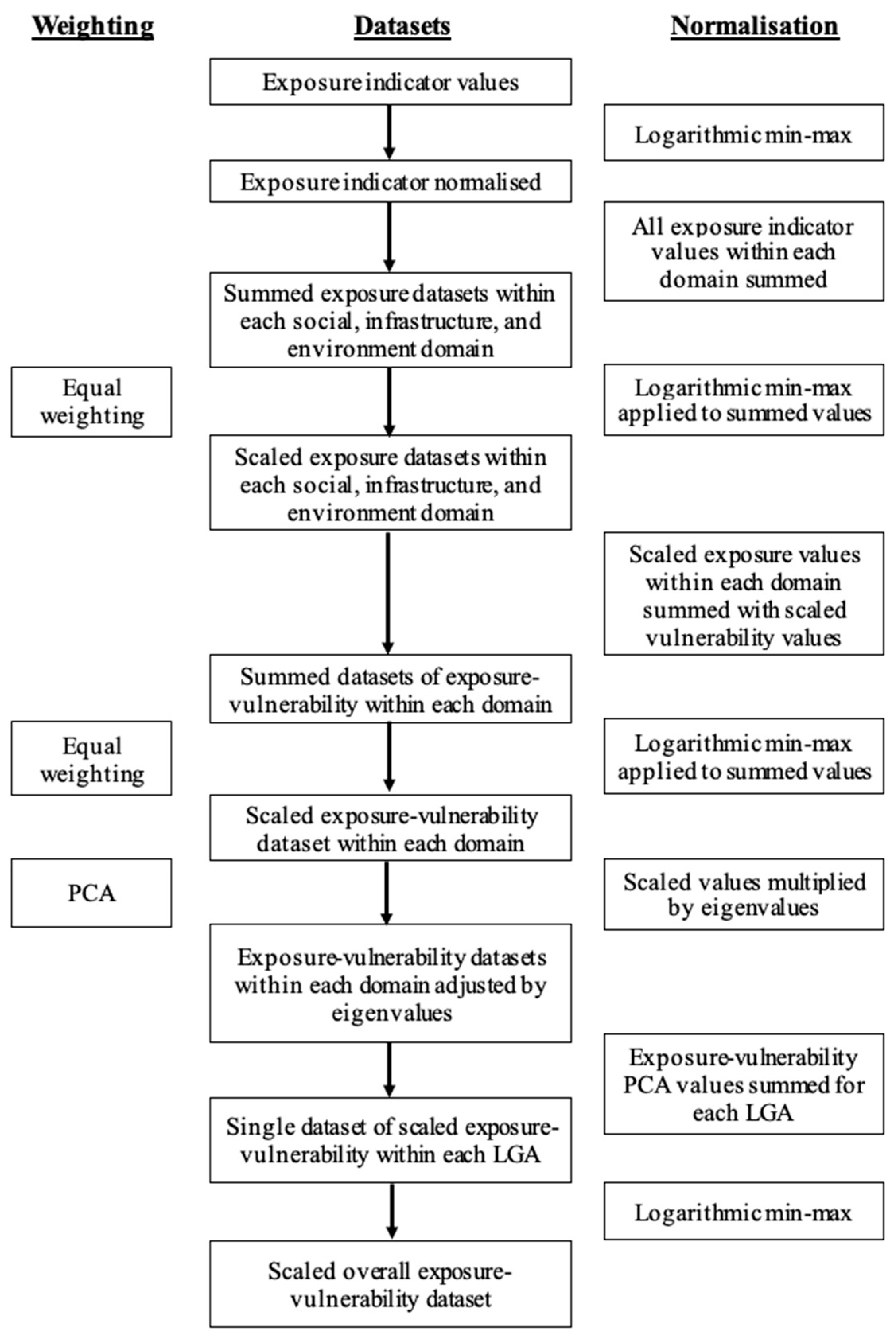

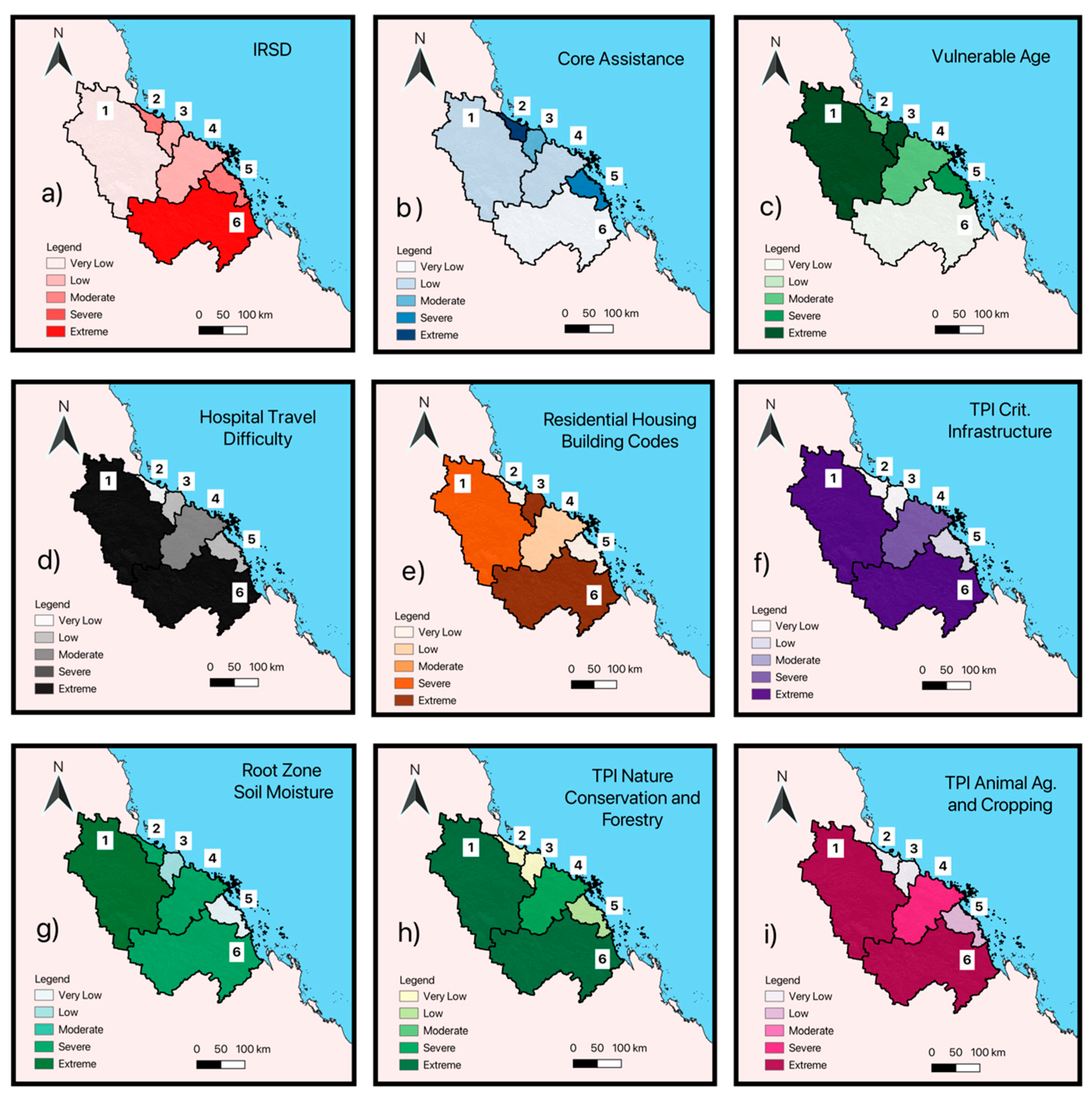

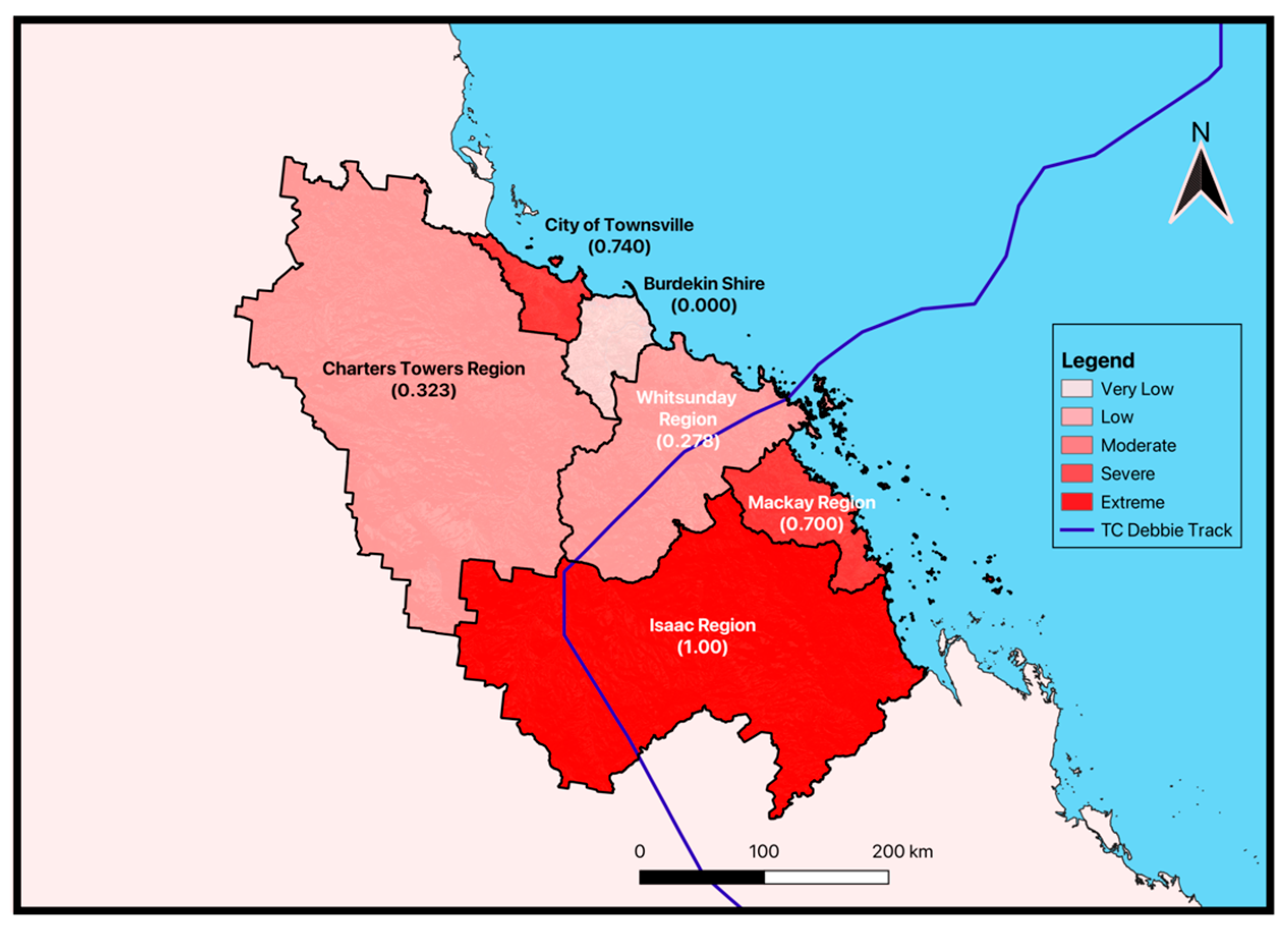
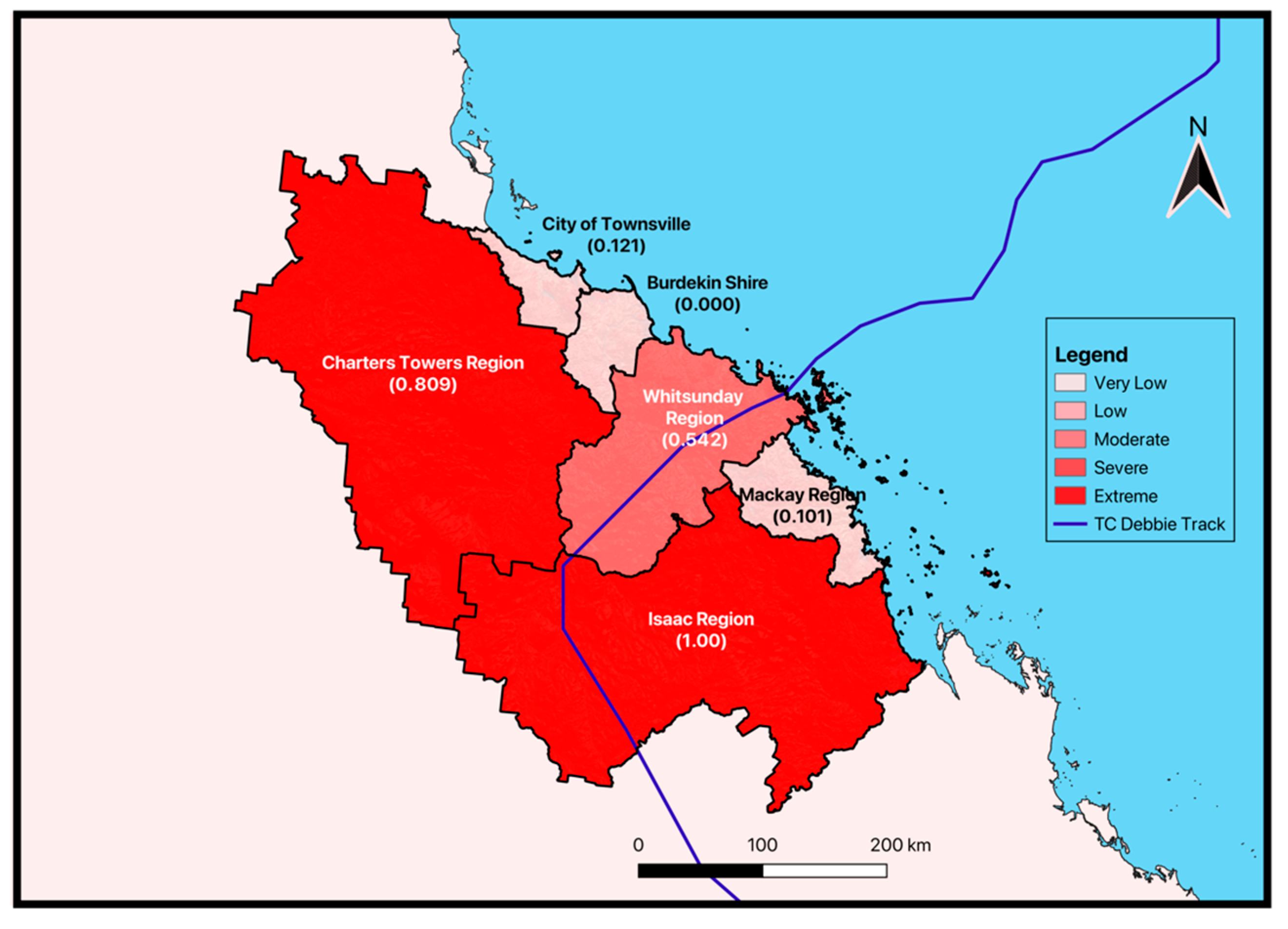
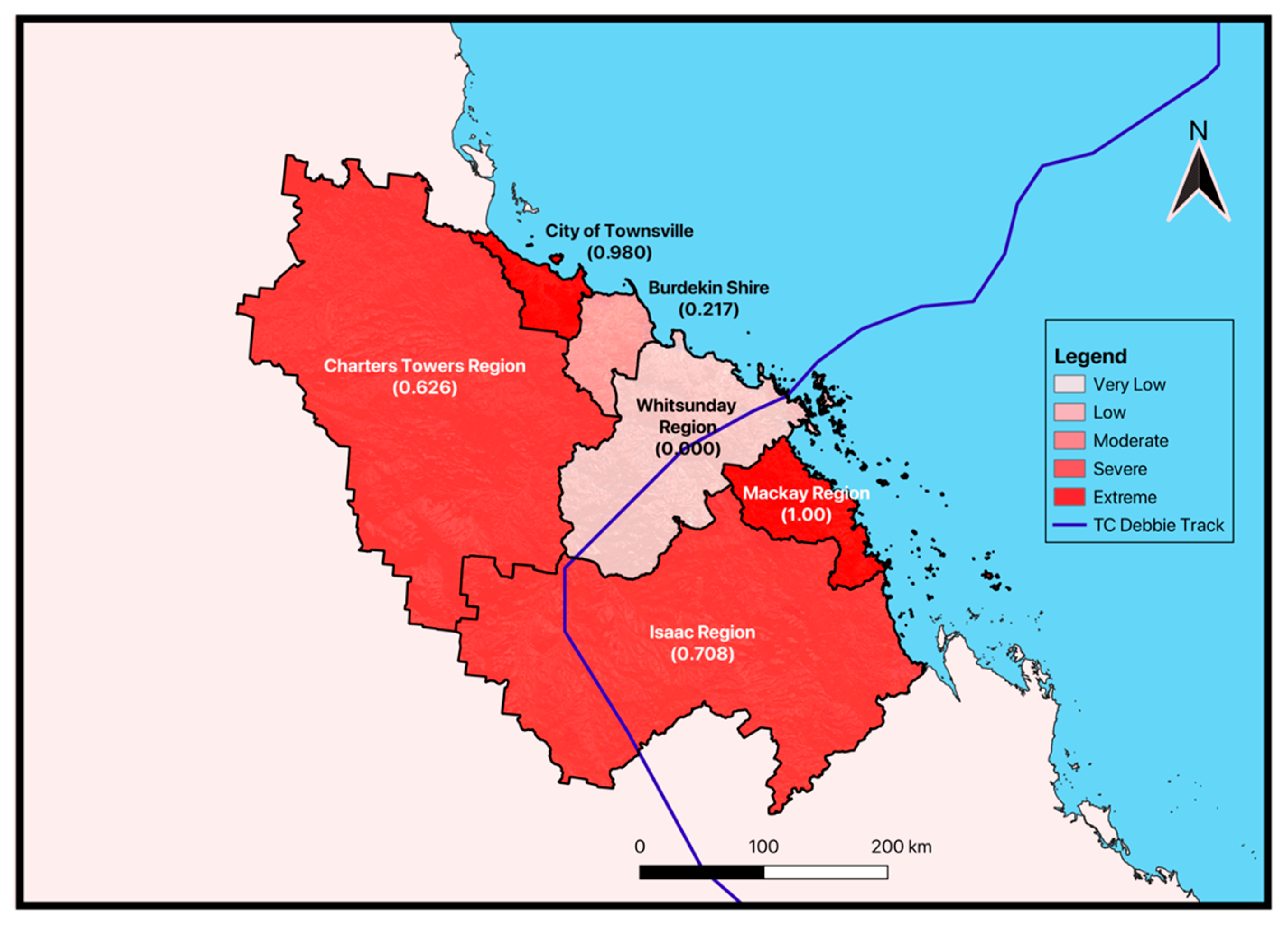
| Domain | Exposure | Vulnerability |
|---|---|---|
| Social | Population Density | Index of Relative Socio-economic Disadvantage (IRSD) |
| Vulnerable Age Groups | ||
| Core Assistance | ||
| Hospital Travel Difficulty | ||
| Infrastructure | Residential Housing Hospitals | Residential Housing Building Codes (pre-1980 construction) |
| Topographic Position Index (TPI) < −24 and Critical Infrastructure | ||
| Environment | Land Use Land Cover (LULC) | Soil Moisture |
| TPI < −24 and Animal Agriculture and Cropping | ||
| TPI < −24 and Nature Conservation and Forestry |
| Risk Groups | Indicator | Dataset | Source | Resolution | Year |
|---|---|---|---|---|---|
| Exposure | Population Density | 2021 Census of Population and Housing | Australian Bureau of Statistics | Local Government Area | 2021 |
| Residential Housing | Cadastral Data—Queensland—by Area of Interest | Queensland Government Open Data Portal | Scales Ranged from Standard 1:2500 to 1:250,000 | 2023 | |
| Hospitals | Hospital and Health Services Map | Queensland Government Health | Local Government Area | 2021 | |
| Land Use Land Cover | Land Use Mapping—1999 to 2013—Southeast Queensland NRM | Queensland Spatial Catalogue | Nominal Scale of 1:50,000 | 2014 | |
| Vulnerability | Index of Relative Socio-economic Disadvantage | Socio-Economic Indexes for Areas (SEIFA) 2016 | Australian Bureau of Statistics | Statistical Area 2 (SA2) | 2016 |
| Vulnerable Age Groups | 2021 Census of Population and Housing | Australian Bureau of Statistics | Local Government Area | 2021 | |
| Core Assistance | 2021 Census of Population and Housing | Australian Bureau of Statistics | Local Government Area | 2021 | |
| Hospital Travel Difficulty | Hospital and Health Service Maps | Queensland Government—Health | Scales Ranged from Standard 1:2500 to 1:250,000 | 2023 | |
| Residential Housing Building Codes (pre-1980 construction) | ABS Australian Statistical Geography Standard SA1 2016 Dataset | National Exposure Information System (NEXIS) | 100 Square Metres | 2016 | |
| Soil Moisture | Australian Water Outlook, Historical, Root Zone | Bureau of Meteorology | 5 km | 2017 | |
| TPI < −24–Critical Infrastructure | GEODATA 9 Second DEM and D8 Flow Direction Grid 2008 Version 3.0 | Geoscience Australia | 9 s (250 m) | 2008 | |
| TPI < −24–Animal Agriculture and Cropping | GEODATA 9 Second DEM and D8 Flow Direction Grid 2008 Version 3.0 | Geoscience Australia | 9 s (250 m) | 2008 | |
| TPI < −24–Nature Conservation and Forestry | GEODATA 9 Second DEM and D8 Flow | Geoscience Australia | 9 s (250 m) | 2008 |
| Classification | Value (Weight Assigned) | Rating |
|---|---|---|
| Critical Infrastructure | 0.9 | Very High |
| Residential | 0.9 | Very High |
| Animal Agriculture | 0.7 | High |
| Cropping | 0.7 | High |
| Nature Conservation | 0.5 | Moderate |
| Forestry | 0.5 | Moderate |
| Water Bodies | 0.1 | Very Low |
| Other | 0.1 | Very Low |
| Class | Very Low | Low | Moderate | Severe | Extreme |
|---|---|---|---|---|---|
| Value | 0–0.20 | 0.21–0.40 | 0.41–0.60 | 0.61–0.80 | 0.81–1 |
| Domain | Vector 1 | Vector 2 | Vector 3 |
|---|---|---|---|
| Social | 0.7376 | 0.2744 | 0.6169 |
| Infrastructure | 0.1105 | 0.8523 | −0.5112 |
| Environment | −0.6661 | 0.4452 | 0.5984 |
Disclaimer/Publisher’s Note: The statements, opinions and data contained in all publications are solely those of the individual author(s) and contributor(s) and not of MDPI and/or the editor(s). MDPI and/or the editor(s) disclaim responsibility for any injury to people or property resulting from any ideas, methods, instructions or products referred to in the content. |
© 2023 by the authors. Licensee MDPI, Basel, Switzerland. This article is an open access article distributed under the terms and conditions of the Creative Commons Attribution (CC BY) license (https://creativecommons.org/licenses/by/4.0/).
Share and Cite
Berman, K.; Kuleshov, Y. Assessing Tropical Cyclone Risk in Australia Using Community Exposure–Vulnerability Indices. Climate 2023, 11, 235. https://doi.org/10.3390/cli11120235
Berman K, Kuleshov Y. Assessing Tropical Cyclone Risk in Australia Using Community Exposure–Vulnerability Indices. Climate. 2023; 11(12):235. https://doi.org/10.3390/cli11120235
Chicago/Turabian StyleBerman, Kade, and Yuriy Kuleshov. 2023. "Assessing Tropical Cyclone Risk in Australia Using Community Exposure–Vulnerability Indices" Climate 11, no. 12: 235. https://doi.org/10.3390/cli11120235
APA StyleBerman, K., & Kuleshov, Y. (2023). Assessing Tropical Cyclone Risk in Australia Using Community Exposure–Vulnerability Indices. Climate, 11(12), 235. https://doi.org/10.3390/cli11120235






